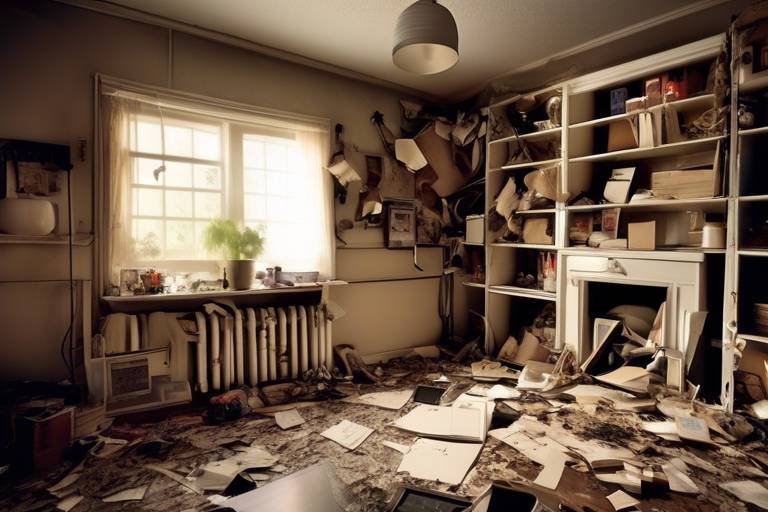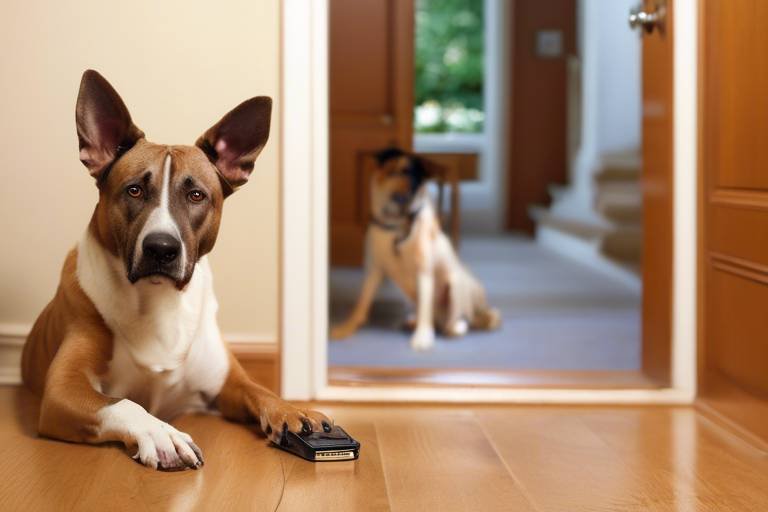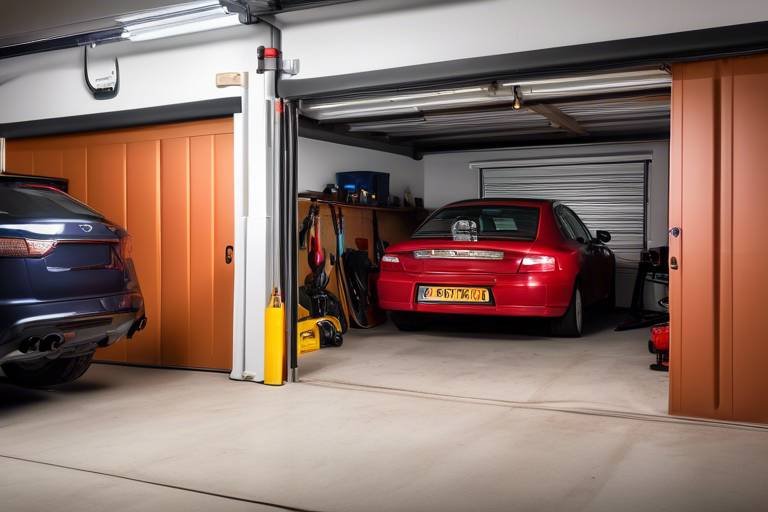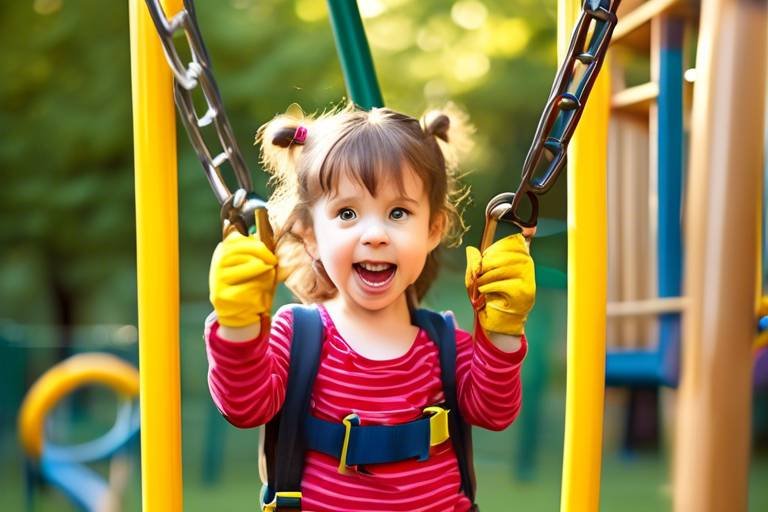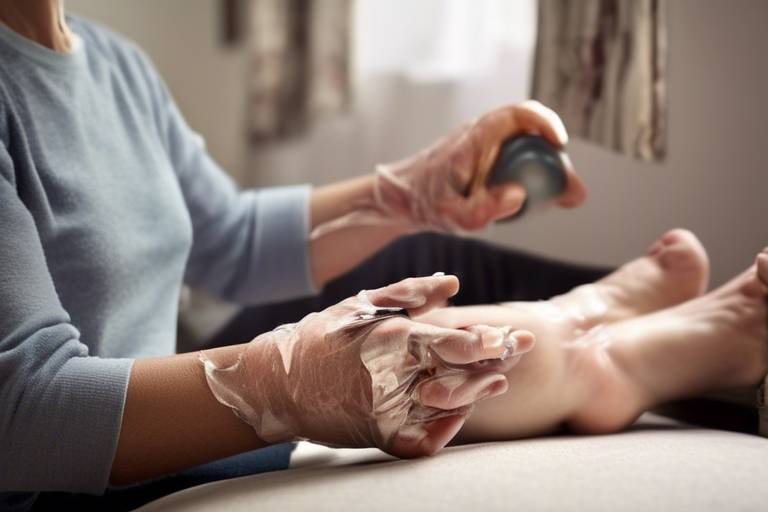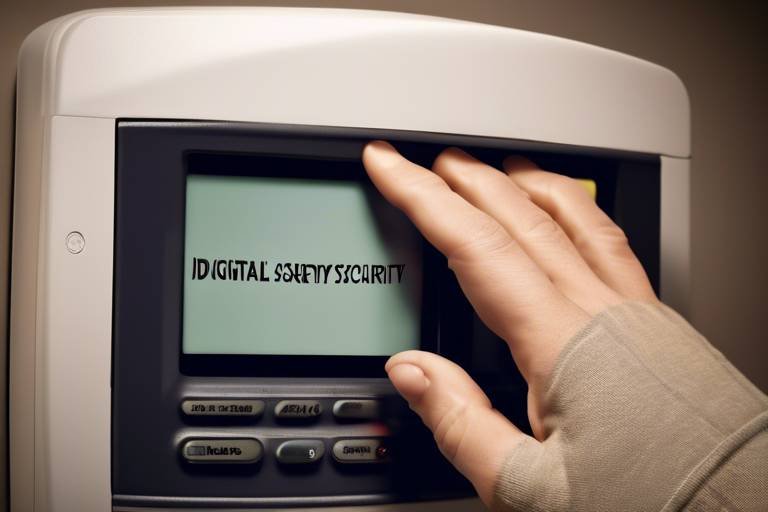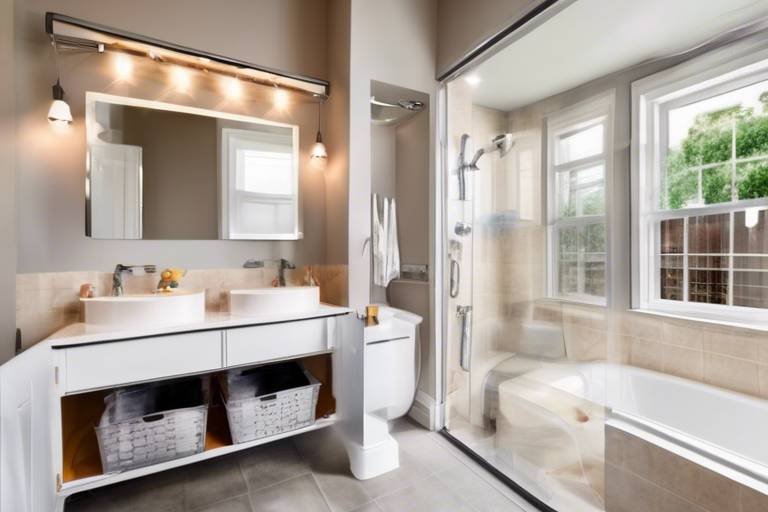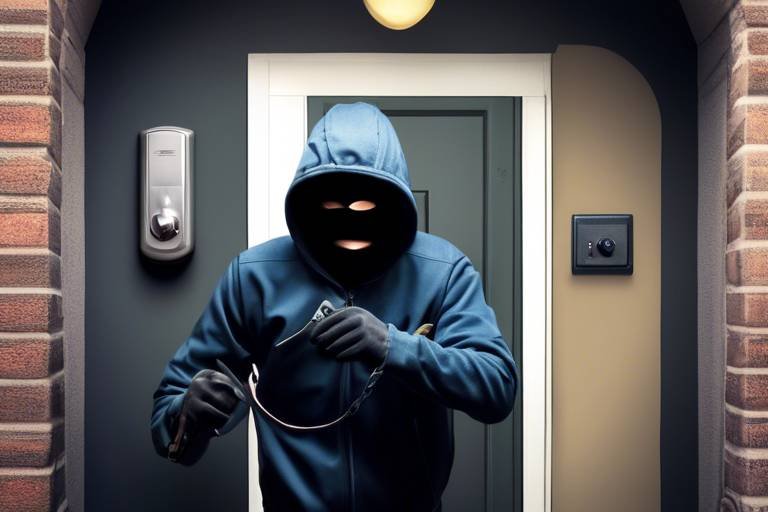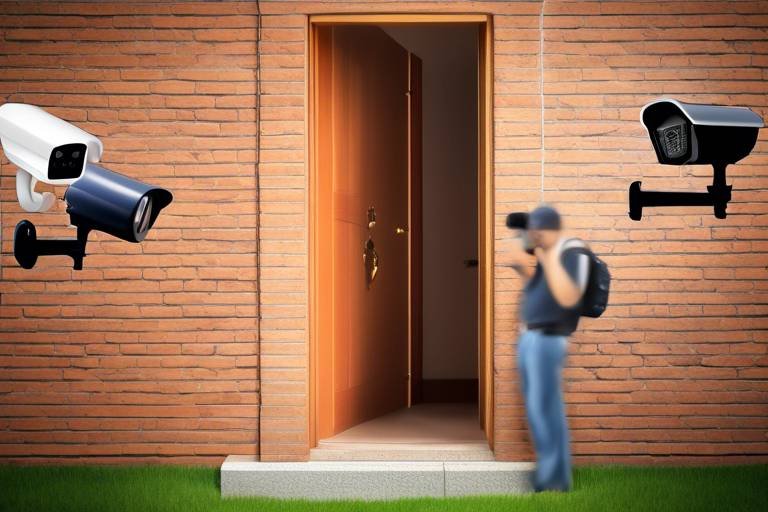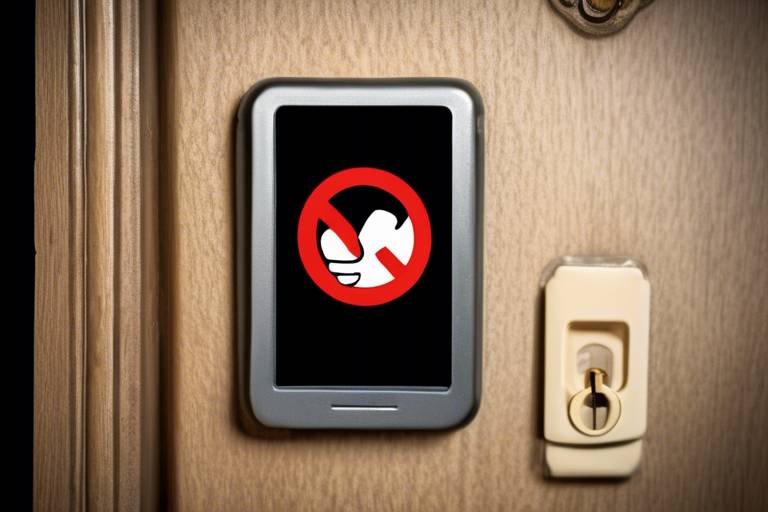Identifying Hidden Dangers Around Your Home
Every home is a sanctuary, a place where we feel safe and comfortable. But did you know that lurking within those familiar walls may be hidden dangers waiting to catch you off guard? It's true! From everyday items to unexpected hazards, understanding these risks is crucial for maintaining a safe living environment for you and your loved ones. In this article, we will explore various hidden dangers that may exist in your home, offering insights on how to identify and mitigate risks effectively. So, let’s dive in and uncover what you might be overlooking!
Many of the items we use daily can pose significant risks if not handled properly. Think about it: how often do you store cleaning products under the sink without a second thought? These seemingly harmless substances can be incredibly dangerous, especially if they are not kept out of reach of children. Electrical appliances also present risks, particularly if they are outdated or damaged. Sharp objects, like knives and scissors, can lead to injuries if not stored safely. Recognizing these hazards is the first step in addressing them.
To effectively manage these common household hazards, consider the following tips:
- Always store cleaning products in locked cabinets or high shelves.
- Inspect electrical cords for frays and replace any damaged appliances.
- Use knife blocks or magnetic strips for safe knife storage.
Fires can start from seemingly harmless sources, and understanding these risks is vital for prevention. For instance, faulty wiring can lead to electrical fires, while unattended candles can quickly escalate into a disaster. Overloaded outlets are another common issue that can spark a fire. To safeguard your home, it’s essential to regularly check your electrical systems, avoid using multiple high-wattage appliances on the same outlet, and never leave candles burning unattended.
The kitchen is often considered the heart of the home, but it’s also a hotspot for accidents. From slips on wet floors to cuts from sharp knives, the kitchen can be a dangerous place if safety isn’t prioritized. To maintain a safe cooking environment, always keep floors dry, use cutting boards to prevent slipping, and ensure that all knives are stored safely. Remember, a little caution can go a long way in preventing kitchen mishaps!
While appliances are designed to make our lives easier, they can also pose risks if not used correctly. Regular maintenance is key! For example, cleaning the lint trap in your dryer can prevent fires, while ensuring your refrigerator is functioning correctly can avoid food spoilage. Always read the manuals for your appliances and follow safety guidelines to minimize risks.
Improper food handling can lead to serious health risks. It’s crucial to store food at the right temperatures and maintain cleanliness in your kitchen. Here are some essential food safety practices:
- Keep raw meats separate from other foods to avoid cross-contamination.
- Ensure your refrigerator is set below 40°F (4°C).
- Wash hands and surfaces often to prevent the spread of bacteria.
If you have children, ensuring their safety is paramount. Childproofing your home involves taking proactive steps to eliminate hazards. This includes securing heavy furniture to walls to prevent tipping, using safety gates to block off stairs, and storing dangerous items, like cleaning supplies and sharp tools, out of reach. Remember, kids are naturally curious, and a little preparation can save you a lot of worry!
Our yards can harbor hidden dangers too. From toxic plants to uneven surfaces, outdoor hazards can pose risks to both children and adults. If you have a garden, be aware of any plants that may be harmful if ingested. Additionally, ensure that walkways are clear and well-maintained to prevent trips and falls. Pool safety is another critical aspect; drowning can happen in seconds, so always supervise children around water.
Gardening is a wonderful hobby, but it comes with its own set of risks. Pesticides can be harmful if ingested or improperly handled, and sharp tools can lead to injuries. Always wear gloves when handling chemicals, and store tools safely after use. By taking simple precautions, you can enjoy your garden without the worry of accidents.
While pools provide endless fun, they can also be a source of danger. To ensure safety, install barriers around the pool, supervise children at all times, and have emergency equipment readily available. Being prepared can make all the difference in preventing accidents and ensuring a safe swimming experience.
Being prepared for emergencies is crucial. Create a safety plan for your family, including escape routes and meeting points in case of fire or other emergencies. Assemble an emergency kit with essentials like water, food, and first aid supplies. Lastly, know your local emergency contacts and keep them accessible. Preparation is the key to safety!
Q: What are the most common household hazards?
A: Common hazards include cleaning products, electrical appliances, sharp objects, and slips and falls.
Q: How can I childproof my home effectively?
A: Secure heavy furniture, use safety gates, and store dangerous items out of reach.
Q: What should I include in my emergency kit?
A: Your emergency kit should include water, non-perishable food, a flashlight, batteries, a first aid kit, and any necessary medications.

Common Household Hazards
Every home is a sanctuary, a place where we feel safe and comfortable. But did you know that your cozy abode might be hiding some ? From the cleaning products under your sink to the electrical appliances buzzing in the background, there are numerous risks lurking around that could potentially harm you and your loved ones. It's crucial to identify these dangers and take proactive steps to mitigate them.
First and foremost, let's talk about cleaning products. While they keep our homes sparkling clean, many of these items contain harsh chemicals that can be harmful if ingested or inhaled. For instance, bleach and ammonia can create toxic fumes when mixed together. Always read labels carefully and store these products out of reach of children. Consider switching to natural cleaning alternatives like vinegar or baking soda, which are less harmful and just as effective.
Next up, we have electrical appliances. These handy devices are a part of our daily lives, but they can also pose serious risks if not used correctly. Faulty wiring, frayed cords, or overloaded outlets can lead to electrical fires. It's essential to regularly inspect your appliances for any signs of wear and tear. If you notice anything unusual, such as sparks or a burning smell, unplug the device immediately and consult a professional. Remember, safety first!
Another often-overlooked hazard in the home is sharp objects. Whether it's a kitchen knife, scissors, or broken glass, these items can lead to painful injuries. Make sure to store knives in a designated drawer or knife block, and always cut away from your body when preparing food. Additionally, keep broken items out of reach and dispose of them safely to prevent accidents.
Lastly, let’s not forget about medications. Many households have a stash of over-the-counter and prescription drugs, which can be dangerous if not stored properly. To prevent accidental ingestion, especially by children, keep medications in child-proof containers and store them in a high cabinet. Regularly check expiration dates and dispose of any unused medications safely.
By being aware of these common household hazards and taking the necessary precautions, you can create a safer environment for yourself and your family. Remember, a little vigilance goes a long way in preventing accidents and ensuring peace of mind in your home.
- What are the most common household hazards? Common hazards include cleaning products, electrical appliances, sharp objects, and medications.
- How can I make my home safer? Regularly inspect your home for potential hazards, store dangerous items out of reach, and use natural cleaning products when possible.
- What should I do if I find a faulty appliance? Unplug the appliance immediately and consult a professional for repairs or replacements.

Fire Risks
When we think about fire risks in our homes, it’s easy to overlook the everyday items that can become potential hazards. Fires can ignite from sources that seem harmless at first glance. For instance, did you know that faulty wiring is one of the leading causes of house fires? If you notice flickering lights or frequently tripped circuit breakers, it might be time to call in a professional electrician to assess the situation. Ignoring these signs is like playing with fire—literally!
Another sneaky culprit is the humble candle. While they can create a cozy ambiance, unattended candles can quickly turn into a disaster. Always remember to blow them out before leaving a room or going to bed. It’s a small step that can save lives. Additionally, overloaded electrical outlets are a common fire risk. If you find yourself using multiple power strips in one outlet, it’s time to rethink your power management. Instead of risking an electrical fire, consider rearranging your electronics or installing additional outlets.
Let’s break down some of the most common fire risks in our homes:
- Faulty Wiring: Look for signs like buzzing sounds or scorch marks.
- Unattended Candles: Always extinguish candles when leaving a room.
- Overloaded Outlets: Avoid plugging too many devices into a single outlet.
- Heating Equipment: Keep flammable materials away from heaters.
To protect your home from these fire risks, it’s crucial to implement preventive measures. Regularly inspect your home for potential hazards, and don’t hesitate to replace old or damaged electrical cords. Installing smoke detectors on every level of your home is a must—test them monthly and change the batteries at least once a year. Having a fire extinguisher in key areas, such as the kitchen and garage, can also be a lifesaver in case of an emergency.
Now, let’s not forget about the kitchen—often referred to as the heart of the home but also a hotspot for fire-related accidents. Cooking is a daily activity that can quickly become dangerous if we’re not careful. Always stay in the kitchen while frying, grilling, or broiling food. If you must leave, even for a moment, turn off the stove. It's similar to leaving a child unattended; you never know what could happen in just a few seconds.
In summary, being aware of the fire risks around your home is the first step toward prevention. By taking proactive measures and staying vigilant, you can create a safer living environment for you and your loved ones.
Q: What should I do if I notice a burning smell in my home?
A: If you detect a burning smell, it’s essential to investigate immediately. Check for any appliances that may be overheating or wires that may be damaged. If you cannot identify the source, evacuate your home and call the fire department.
Q: How often should I check my smoke detectors?
A: You should test your smoke detectors monthly and replace the batteries at least once a year. If the detector is more than ten years old, consider replacing it entirely.
Q: What are the best fire prevention tips for the kitchen?
A: Always stay in the kitchen while cooking, keep flammable materials away from the stove, and have a fire extinguisher handy. Also, make sure to regularly clean your cooking surfaces to prevent grease buildup.

Kitchen Safety
The kitchen is often referred to as the heart of the home, but it can also be a danger zone if we’re not careful. With sizzling pans, sharp knives, and slippery floors, it’s crucial to be aware of the potential hazards lurking in your culinary haven. Have you ever thought about how a simple oversight, like leaving a pot unattended, can lead to a kitchen disaster? Let's dive into the common risks and how to keep your kitchen a safe space for everyone.
One of the primary concerns in any kitchen is slips and falls. Spills can happen in the blink of an eye, whether it's water splashed while washing dishes or oil dripped on the floor while cooking. To combat this, it’s important to clean up any spills immediately and consider using non-slip mats in high-traffic areas. Additionally, wearing shoes with good grip can significantly reduce the chances of slipping. It's a small change that can make a huge difference in preventing accidents.
Sharp objects are another major hazard. Knives, graters, and peelers can be incredibly useful, but they can also cause serious injuries if not handled properly. Always use a cutting board and keep knives in a designated area, preferably in a knife block or magnetic strip, to avoid accidental cuts. When you’re done using a knife, make sure it’s cleaned and stored away safely. Remember, it’s not just about using these tools correctly, but also about teaching children the importance of kitchen safety when they’re old enough to help out.
Burns are a common kitchen injury, often occurring from hot surfaces or boiling liquids. To minimize the risk, always use oven mitts when handling hot pots and pans, and never leave cooking food unattended. Did you know that the majority of kitchen fires start because food is left on the stove? It’s a good practice to set a timer to remind you when to check on your dishes. Moreover, keep flammable items like dish towels and paper near the stove at a safe distance.
Another aspect of kitchen safety involves the use of electrical appliances. From toasters to blenders, these devices can make cooking easier, but they can also pose risks if not used properly. Always read the manufacturer’s instructions before using an appliance. Ensure that cords are kept out of reach of water and that they are not frayed or damaged. Regular maintenance is key; check your appliances periodically to ensure they are in good working condition. If you notice any issues, it’s best to address them immediately to avoid potential hazards.
Lastly, let’s talk about food safety. It’s not just about cooking; it’s about handling and storing food correctly to prevent foodborne illnesses. Always wash your hands before and after preparing food, and ensure that raw meat is kept separate from other ingredients. Use a food thermometer to check that your meals reach the right temperatures, and don’t forget to refrigerate leftovers promptly. By following these simple practices, you can keep your kitchen not only a place of joy but also a sanctuary of safety.
In conclusion, kitchen safety is all about being mindful and proactive. By recognizing the common hazards and taking the necessary precautions, you can create a cooking environment that is not only enjoyable but also safe for everyone. Remember, a little awareness goes a long way in preventing accidents and injuries in the kitchen.
- What should I do if I cut myself while cooking? Clean the wound with soap and water, apply an antiseptic, and cover it with a bandage. If the bleeding doesn’t stop, seek medical attention.
- How can I prevent kitchen fires? Never leave cooking food unattended, keep flammable items away from the stove, and have a fire extinguisher readily available.
- What are the best practices for food storage? Store perishable items in the refrigerator, keep raw meat separate from other foods, and label leftovers with dates.

Appliance Safety
When it comes to keeping your home safe, is often overlooked, yet it plays a crucial role in preventing accidents and injuries. Think about it: we rely on our appliances daily, from washing machines to microwaves, but how often do we consider the potential risks they pose? It's essential to recognize that while these devices make our lives easier, they can also become hazards if not used or maintained properly.
First and foremost, regular maintenance of appliances is key. Just like a car needs oil changes and tune-ups, your appliances require periodic checks to ensure they are functioning correctly. For instance, a refrigerator that isn't cooling properly can lead to spoiled food, while a dryer with lint buildup can become a fire hazard. Make it a habit to inspect your appliances regularly and address any issues immediately. If you notice unusual noises or smells, it's time to take action!
Another critical aspect of appliance safety is understanding how to use them correctly. Each appliance comes with a user manual that provides essential information about its operation and safety precautions. Have you ever skimmed through a manual and thought, "I don't need this; I know how to use it"? Well, think again! That manual contains vital safety tips that can help you avoid mishaps. For example, using a toaster near water can lead to electric shock, and overloading an extension cord can cause overheating. Always follow the manufacturer's guidelines to ensure safe operation.
Here are some practical safety tips to keep in mind:
- Keep appliances away from water sources to prevent electric shock.
- Unplug appliances when not in use, especially those that generate heat, like toasters and irons.
- Ensure that cords are not frayed or damaged to avoid electrical fires.
- Use appliances on stable surfaces to prevent tipping or spills.
Moreover, it's essential to educate everyone in your household about appliance safety, especially children. Kids are naturally curious and may not understand the dangers associated with certain appliances. Establish clear rules about appliance usage and supervise them when they are in the vicinity of potentially dangerous devices. Consider installing safety locks on appliances that pose a risk, such as ovens and dishwashers, to prevent unsupervised access.
In conclusion, appliance safety is an integral part of maintaining a secure home environment. By staying vigilant about maintenance, using appliances correctly, and educating your family, you can significantly reduce the risks associated with household appliances. Remember, a little caution goes a long way in ensuring your home remains a safe haven for you and your loved ones.
Q: What should I do if an appliance is making strange noises?
A: If an appliance is making unusual noises, it's best to turn it off immediately and unplug it. Check for any visible issues, such as loose parts or blockages. If the problem persists, consult a professional technician.
Q: How can I prevent electrical fires caused by appliances?
A: To prevent electrical fires, avoid overloading outlets, regularly inspect cords for damage, and ensure that appliances are turned off and unplugged when not in use. Additionally, consider installing smoke detectors in key areas of your home.
Q: Are there specific appliances that require more attention for safety?
A: Yes, appliances that generate heat, such as ovens, toasters, and space heaters, require extra attention. Ensure they are used according to the manufacturer's instructions and are kept away from flammable materials.

Food Safety
When it comes to ensuring the health and well-being of your family, should be at the top of your priority list. The kitchen is often considered the heart of the home, but it can also be a breeding ground for harmful bacteria and foodborne illnesses if proper precautions aren't taken. It's essential to understand that food safety is not just about cooking; it encompasses everything from storage to preparation and even cleanliness. So, how can you create a safe culinary environment? Let's dive into some essential practices that can help you keep your kitchen safe.
First and foremost, proper storage is crucial. Did you know that the way you store food can significantly impact its safety? For instance, perishable items like meat, dairy, and certain fruits should always be kept in the refrigerator at temperatures below 40°F (4°C). To make things easier, consider using a
| Food Type | Storage Temperature | Storage Duration |
|---|---|---|
| Meat | Below 40°F (4°C) | 1-2 days (raw), 3-4 days (cooked) |
| Dairy | Below 40°F (4°C) | 1 week (after opening) |
| Fruits & Vegetables | Below 40°F (4°C) | Varies (check specific types) |
Next up is the importance of maintaining cleanliness in your kitchen. This means regularly cleaning your countertops, utensils, and cutting boards to prevent cross-contamination. Did you know that using the same cutting board for raw meat and vegetables can lead to serious health risks? To avoid this, consider having separate cutting boards for different types of food. It's not just about cleanliness, though; it's about being proactive. Always wash your hands before handling food, and encourage your family to do the same. This simple act can significantly reduce the risk of spreading bacteria.
Now, let’s talk about cooking temperatures. Did you know that not all foods are safe to eat at the same temperature? For instance, ground meats should be cooked to an internal temperature of 160°F (71°C), while poultry needs to reach at least 165°F (74°C) to be considered safe. Investing in a reliable food thermometer can help you accurately gauge these temperatures and ensure your meals are safe to consume. Here’s a quick reference for safe cooking temperatures:
| Food Item | Safe Cooking Temperature |
|---|---|
| Ground Meat | 160°F (71°C) |
| Poultry | 165°F (74°C) |
| Fish | 145°F (63°C) |
Lastly, don’t forget about the importance of leftovers. It’s easy to forget about that half-eaten lasagna in the fridge, but leftovers can pose a risk if not handled correctly. Always store leftovers in airtight containers and consume them within three to four days to minimize the risk of foodborne illness. If you’re unsure, remember the motto: “When in doubt, throw it out!”
By implementing these food safety practices, you can create a healthier kitchen environment for you and your loved ones. Remember, it’s not just about cooking; it’s about creating a safe space where everyone can enjoy delicious meals without the worry of hidden dangers lurking in the food.
- What is the best way to store leftovers? Always use airtight containers and consume them within three to four days.
- How can I prevent cross-contamination? Use separate cutting boards for raw meats and vegetables, and always wash your hands before handling food.
- What temperature should I cook chicken to? Chicken should be cooked to an internal temperature of at least 165°F (74°C).

Childproofing Your Home
When it comes to creating a safe haven for your little ones, childproofing your home is not just a good idea—it's essential. Imagine your home as a treasure chest filled with wonders, but lurking within are hidden dangers that could turn an adventure into a mishap. Every corner holds potential risks, and as a parent, your mission is to uncover and mitigate these threats before they can cause harm. So, where do you start?
First and foremost, secure furniture that could tip over. Heavy items like bookshelves and dressers should be anchored to the wall to prevent them from falling if your child decides to climb or pull on them. It's a simple yet effective measure that can save lives. Additionally, consider the layout of your home. Are there sharp corners on tables or low-lying furniture? Investing in corner guards can transform those hazardous edges into soft barriers, making your space much safer for curious toddlers.
Next, let’s talk about safety gates. These are your best friends when it comes to controlling access to certain areas of your home, especially stairs. A sturdy gate can prevent falls and give you peace of mind while your child explores. Remember, the gates should be installed at both the top and bottom of staircases, and they should be properly secured to withstand any enthusiastic pushing or pulling.
Now, let’s dive into the world of storage. Children are naturally inquisitive, and they tend to explore everything within reach. To keep dangerous items out of their curious hands, consider the following:
- Store cleaning products in locked cabinets.
- Keep sharp objects, like knives and scissors, out of reach or in locked drawers.
- Use childproof latches on cabinets and drawers to prevent access.
In addition to securing dangerous items, it’s wise to evaluate your home for toxic plants. Many common household plants can be harmful if ingested. Check your greenery and either remove or place them out of reach. If you’re unsure which plants are safe, a quick online search can provide you with a list of toxic and non-toxic varieties.
Don’t forget about the bathroom! This is a hotspot for accidents. Install non-slip mats to prevent slips and falls, and always keep medications and personal care products stored out of reach or in locked cabinets. Children are naturally drawn to colorful bottles and shiny objects, so it’s crucial to keep these items safely tucked away.
Finally, remember that childproofing is not a one-time task. As your child grows and becomes more mobile, your home will require continual adjustments. Regularly reassess your environment and be proactive in making changes to ensure their safety. It’s like a never-ending game of hide and seek, where your little one is always discovering new things, and you need to stay one step ahead!
1. When should I start childproofing my home?
Childproofing should begin before your baby starts to crawl, as they will soon be exploring their surroundings. It's never too early to start making your home safer!
2. How can I ensure my child is safe around electrical outlets?
Use outlet covers to prevent little fingers from poking into outlets. Additionally, consider using tamper-resistant outlets, which are designed to prevent accidental insertion of foreign objects.
3. Are there any specific safety products you recommend?
Definitely! Look for safety gates, corner guards, outlet covers, cabinet locks, and non-slip mats. Each of these products plays a vital role in keeping your child safe.
4. How often should I reassess my childproofing measures?
As your child grows and develops new skills, it’s important to reassess your home every few months. Regular checks will help you stay ahead of potential hazards.

Outdoor Dangers
When we think of our homes, we often focus on the interior, overlooking the potential hazards lurking right outside our doors. The outdoors can be a treasure trove of fun and adventure, but it can also hide some serious dangers that could jeopardize our safety and well-being. From toxic plants to uneven surfaces, it's important to be vigilant about the risks associated with our outdoor spaces.
One of the most common outdoor dangers is the presence of toxic plants. Many plants that look beautiful can be harmful, especially to children and pets. For instance, plants like poison ivy, oleander, and foxglove can cause skin irritation or more severe health issues if ingested. It’s crucial to educate yourself and your family about these plants. You might consider creating an informative guide that includes:
| Plant Name | Potential Hazard |
|---|---|
| Poison Ivy | Skin irritation, allergic reactions |
| Oleander | Cardiac issues if ingested |
| Foxglove | Heart problems if ingested |
Another outdoor risk to consider is the condition of your yard. Uneven surfaces, such as potholes or uneven paving stones, can lead to trips and falls. Regularly inspecting your outdoor pathways and making necessary repairs can help mitigate these risks. It’s also wise to keep walkways clear of debris and clutter. Remember, a little maintenance goes a long way in preventing accidents.
When it comes to outdoor play areas, particularly if you have children, safety should be your top priority. Supervision is key, but so is the installation of safety features. For instance, if you have a swing set or a trampoline, ensure they are placed on soft ground, ideally with a layer of mulch or grass to cushion any falls. Additionally, consider using safety gates to restrict access to potentially dangerous areas, such as pools or steep steps.
Speaking of pools, they can be a source of joy during hot summer days, but they also pose significant risks. Drowning can happen in a matter of seconds, so it’s essential to establish strict safety measures. Always supervise children around water, and consider installing fencing with self-closing gates to prevent unsupervised access. Additionally, having a rescue flotation device nearby can be a lifesaver in emergencies.
In summary, while our outdoor spaces can be a haven for relaxation and fun, they also harbor hidden dangers that require our attention. By being proactive about identifying and mitigating these risks, we can create a safer environment for ourselves and our loved ones. Remember, safety is not just a priority; it’s a way of life!
Q: What are some common toxic plants to watch out for in my yard?
A: Common toxic plants include poison ivy, oleander, and foxglove. It's important to familiarize yourself with these plants and educate your family about their dangers.
Q: How can I make my yard safer for children?
A: Ensure that play areas have soft surfaces, supervise children closely, and install safety gates to restrict access to dangerous areas like pools.
Q: What should I do if I encounter a poisonous plant?
A: If you come into contact with a poisonous plant, wash the affected area with soap and water immediately. If symptoms persist, seek medical attention.
Q: How can I prevent slips and falls in my yard?
A: Regularly inspect your outdoor pathways for hazards, keep them clear of debris, and repair any uneven surfaces to minimize the risk of accidents.

Garden Safety
Gardening is a delightful way to connect with nature, enjoy fresh air, and beautify your surroundings. However, it’s essential to recognize that this seemingly peaceful activity can also harbor hidden dangers. From sharp tools to toxic plants, being aware of potential risks can make your gardening experience both enjoyable and safe. Have you ever thought about how a simple gardening tool can turn into a hazard if not handled properly? Just like a chef respects their knives, a gardener must respect their tools.
First and foremost, let’s talk about tools. Sharp implements such as shears, hoes, and trowels are vital for garden maintenance, but they can also lead to serious injuries if not used cautiously. Always remember to store your tools in a safe place, ideally in a locked shed or high up on a shelf where children cannot access them. Additionally, it’s crucial to inspect your tools regularly for any wear and tear. A rusted blade or a loose handle can be a recipe for disaster. If you’re unsure about the condition of your tools, it might be best to replace them rather than risk injury.
Another significant concern is the use of pesticides and fertilizers. While these products can protect your plants from pests and diseases, they can also pose health risks to humans and pets if not handled correctly. Always read the labels carefully and follow the manufacturer’s instructions. If you have children or pets, consider using organic alternatives or natural pest control methods. For instance, introducing beneficial insects, like ladybugs, can help manage pests without the need for harsh chemicals. Remember, the goal is to create a thriving garden while keeping it safe for everyone.
Furthermore, be cautious of toxic plants in your garden. Some common plants, such as foxglove, oleander, and certain types of mushrooms, can be extremely toxic if ingested. If you have little ones or curious pets, it’s wise to research and identify any potentially dangerous plants in your garden. You might even want to consider labeling them clearly or removing them altogether. Knowledge is power, and understanding the plants in your garden can prevent unfortunate accidents.
Lastly, don’t forget about your own personal safety. Gardening often involves bending, lifting, and repetitive motions, which can lead to injuries if you’re not careful. Always warm up before starting your gardening tasks and take breaks when needed. Staying hydrated is also crucial, especially on hot days. Utilize sunscreen and wear protective clothing to shield yourself from harmful UV rays. After all, a sunburn can ruin your gardening joy just as quickly as a thorn can!
In summary, practicing is all about being aware and taking precautions. By respecting your tools, being mindful of chemicals, recognizing toxic plants, and prioritizing your own health, you can create a safe and enjoyable gardening experience. So, the next time you step into your garden, remember to keep safety at the forefront of your mind. It’s not just about growing beautiful plants; it’s about ensuring that your gardening adventures are free from hidden dangers.
- What are some common garden tools that can be dangerous?
Common garden tools that can pose dangers include shears, hoes, trowels, and spades. Always handle them with care and store them safely when not in use. - How can I identify toxic plants in my garden?
Researching your plants and consulting local gardening resources can help you identify toxic species. Additionally, consider using apps that can recognize plants for you! - What are some safe alternatives to chemical pesticides?
Organic alternatives include neem oil, insecticidal soap, and introducing beneficial insects like ladybugs to help control pests naturally. - How can I prevent injuries while gardening?
Warm up before gardening, use proper lifting techniques, take breaks, and stay hydrated to minimize the risk of injuries.

Pool Safety
When the sun is shining and the temperature rises, there’s nothing quite like a refreshing dip in your pool. However, while pools can be a source of **fun** and **relaxation**, they can also pose significant dangers if proper safety measures aren’t in place. Imagine a serene day by the water, but suddenly, an accident occurs—this is a scenario we all want to avoid. To ensure that your pool remains a safe haven for family and friends, it’s essential to implement a few critical safety practices.
First and foremost, **supervision** is key. Never leave children unattended near the pool, even for a moment. A child can slip into the water in the blink of an eye. It’s a good idea to establish a “designated adult” rule, where one responsible person is always keeping an eye on the swimmers. This can be a game-changer, especially during lively pool parties.
In addition to supervision, consider installing **safety barriers** around your pool. A fence that is at least four feet high and equipped with a self-closing, self-latching gate can significantly reduce the risk of unsupervised access. Think of it as a safety moat—keeping little ones and pets at bay while allowing the fun to continue safely. Furthermore, ensure the fence is free of any gaps or footholds that could allow a child to climb over.
Another vital aspect of pool safety is having **rescue equipment** readily available. This includes life rings, reaching poles, and a first aid kit. Make sure that everyone in your household knows where these items are stored. In an emergency, seconds count, and being prepared can make all the difference. You might even consider taking a CPR course to be better equipped to handle any unforeseen incidents.
Moreover, it's essential to educate everyone about the **pool rules**. Create a list of dos and don’ts that everyone should follow while enjoying the water. Here are some examples:
- No running around the pool area.
- No diving in shallow water.
- Always wait 30 minutes after eating before swimming.
- Use flotation devices for non-swimmers.
Lastly, be aware of the potential hazards that can arise from **pool chemicals**. Proper storage and handling of pool chemicals is crucial to prevent accidents. Always keep them in a locked cabinet out of reach of children and pets. Additionally, ensure that you follow the manufacturer’s instructions for safe usage, and never mix different chemicals together, as this can create dangerous reactions.
Q: What should I do if someone is drowning?
A: If someone is drowning, call for help immediately and throw them a flotation device. If you are trained in CPR, begin administering it as soon as it is safe to do so.
Q: How can I keep my pool clean and safe?
A: Regularly check the pool’s chemical levels, clean the filters, and remove debris. This not only keeps the pool inviting but also reduces the risk of algae and bacteria growth.
Q: Are pool alarms effective?
A: Yes! Pool alarms can alert you when someone enters the pool area, providing an extra layer of security, especially for young children.
By taking these precautions and remaining vigilant, you can enjoy your pool while ensuring the safety of everyone who takes a dip. Remember, safety is not just a set of rules; it's a way of life that allows you to enjoy your pool without worry!

Emergency Preparedness
Being prepared for emergencies is not just a good idea; it’s essential for ensuring your family's safety. Emergencies can strike at any moment, whether it’s a natural disaster, a medical emergency, or even a power outage. The key to facing these situations head-on is to have a solid plan in place. So, how do you get started? Well, first things first, you need to create a comprehensive safety plan. This plan should outline what to do in various scenarios, from evacuating your home to sheltering in place. Think of it as your family’s emergency roadmap, guiding you through the chaos.
Next, assembling an emergency kit is crucial. This kit should contain all the essentials your family might need in the event of an emergency. But what should go into this kit? Here’s a quick rundown of some must-have items:
- Water: At least one gallon per person per day for three days.
- Food: Non-perishable items that can last for at least three days.
- First Aid Kit: Bandages, antiseptics, and any necessary medications.
- Flashlight: With extra batteries, because you never know when the power might go out!
- Multi-tool: A handy gadget for various situations.
Once you’ve got your kit ready, it’s time to familiarize everyone in your household with the emergency plan. This means sitting down and discussing the plan, conducting practice drills, and ensuring everyone knows where the emergency kit is stored. Think of it like a fire drill at school; repetition helps reinforce the knowledge, making everyone feel more confident when it really counts.
Moreover, knowing local emergency contacts is another vital piece of the puzzle. Make a list of important numbers, including local fire departments, police stations, and hospitals. Keep this list in a visible spot, like on the fridge, so that everyone can easily access it when needed. You might even want to consider downloading emergency apps that provide real-time alerts and information specific to your area. These apps can be lifesavers, offering guidance and updates when you need them most.
Lastly, it’s essential to adapt your emergency preparedness plan to fit your family’s unique needs. If you have pets, make sure to include their supplies in your emergency kit. If someone in your home has a medical condition, ensure that their medications and medical supplies are easily accessible. By personalizing your plan, you’re not just preparing for emergencies; you’re also instilling a sense of security and confidence in your loved ones.
Q: How often should I update my emergency kit?
A: It’s a good idea to review and update your emergency kit at least once a year, or whenever there are significant changes in your family’s needs, such as a new baby or a pet.
Q: What should I do if I have to evacuate?
A: If you need to evacuate, follow the routes outlined in your emergency plan, stay calm, and take your emergency kit with you. Always inform someone outside your home about your whereabouts.
Q: How can I prepare for natural disasters specific to my area?
A: Research the types of natural disasters that are common in your area—like hurricanes, earthquakes, or floods—and tailor your emergency plan and kit accordingly. Local government websites often provide resources and checklists specific to your region.
Frequently Asked Questions
-
What are some common household hazards I should be aware of?
Common household hazards include cleaning products, electrical appliances, sharp objects, and even clutter. It’s essential to regularly check for these items and ensure they are stored safely and used properly to minimize risks.
-
How can I prevent fire risks in my home?
To prevent fire risks, you should regularly inspect your electrical wiring, avoid overloading outlets, and never leave candles unattended. Installing smoke detectors and having a fire extinguisher on hand can also significantly enhance your safety.
-
What kitchen safety tips should I follow?
In the kitchen, always keep knives out of reach of children, use non-slip mats to prevent slips, and be cautious when handling hot items. It’s also a good idea to keep a fire extinguisher nearby in case of cooking emergencies.
-
How do I childproof my home effectively?
Childproofing your home involves securing heavy furniture to the walls, using safety gates at stairways, and keeping hazardous items, such as cleaning supplies and sharp tools, out of reach. Regularly checking your home for potential dangers is crucial.
-
What outdoor dangers should I be aware of?
Outdoor dangers can include toxic plants, uneven surfaces, and pool hazards. It’s vital to familiarize yourself with the plants in your yard and ensure that your pool area is secure with proper barriers and supervision.
-
What are some safe gardening practices?
When gardening, always wear gloves and protective eyewear, and be cautious with pesticides and sharp tools. Additionally, make sure to keep your gardening area tidy to avoid tripping hazards.
-
How can I ensure pool safety?
To ensure pool safety, install a fence around the pool, use pool covers, and always supervise children when they are swimming. Having a first aid kit and knowing basic CPR can also prepare you for emergencies.
-
What steps should I take for emergency preparedness?
Effective emergency preparedness includes creating a safety plan for your family, assembling an emergency kit with essentials, and knowing local emergency contacts. Regularly practicing your plan can help everyone feel more secure.

